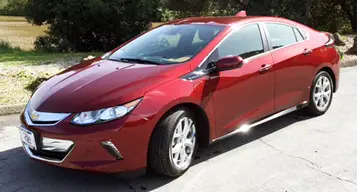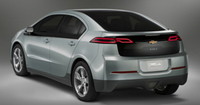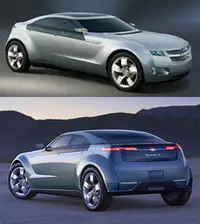2017 Chevy Volt Review by Del Coates +VIDEO
 2017 Chevrolet Volt |
By Del Coates
Prof. Emeritus, San Jose State University
Prof. of Industrial Design & Ergonomics, San Jose State University
Prof. of Industrial Design, College for Creative Studies (CCS), Detroit MI
 2017 Chevrolet Volt |
SAN JOSE, CA: Chevrolet's Gen 2 (second generation) Volt appeared briefly as a 2016 model in just 11 states. It's now available, for a few dollars more, in all 50 states as a 2017 model. It represents an impressive improvement among hybrid cars that reminds me more of a Tesla than a Prius.
 Gen 1 Volt |
Like the Gen 1 Volt of 2011 through 2015, the new Volt is a compact four-door hatchback sedan. But it isn't merely a refreshed version. General Motors stresses that every component, including its battery, engine, generator, electric motors, suspension, and body structure are all new and significantly better than its predecessor's.
 2007 Volt Concept |
Heritage
The Volt's progenitor, called the Volt Concept, was a show car unveiled
at the 2007 Detroit Auto Show. I never warmed to its butch looks. It
reminds me of too many dream cars conjured by designers who, knowing their
visions aren't meant for real garages, take leave of practical impositions
like adequate headroom inside and aerodynamic efficiency outside. The
Concept's designers opted for more titillating stylistic notions like a
muscular, hunkered-down look suggesting aggressive power instead of the
aerodynamic slipperiness so important to electric car efficiency.
Oversize wheels imply power and eagerness. But in the real world they would entail needless unsprung weight, which would compromise ride quality, handling, turning radius and, again, efficiency. The truncated rear end promises precious little trunk capacity. The superfluous pieces of glass over the lower portions of the side windows reduce effective window openings and serve no utilitarian purpose. No real harm done, though; the car was only meant for show.
 GM Diesel-Electric Locomotive |
While considering the Volt's unique character and heritage, I'm reminded that it was not General Motors' first hybrid. That distinction belongs to the diesel-electric locomotives produced by GM's Electro-Motive Division between 1941 and 2005. They drove to extinction the less efficient steam-powered locomotives that were the mainstay of American railroads for over a century. Heading legendary streamliners like the Santa Fe Railroad's Super Chief and El Capitan, they could reach 110 mph.
Like the big-rig diesel trucks cruising the highways, a locomotive powered by only a diesel engine would require a multispeed transmission able to deliver just the right mix of speed and power whether pulling out of a station, cruising at high speed, or climbing a mountain. Imagine the lurching ride passengers might have to endure, however, as the driver frequently shifted gears and let out the clutch.
An enormous automatic transmission patterned after the Hydra-matic units fitted to GM's cars might have eased the driver's task and smoothed the ride but would have added considerable cost and inefficiency. Distributing the engine's power to the locomotive's eight drive wheels would have required complex, power-sapping assemblies of shafts, gears, and flexible joints subject to failure without frequent and costly maintenance.
Consequently, many parts of the world came to rely on trains powered by electricity alone. Simple, reliable copper wires distributed power to motors at each wheel. No complicated mechanisms or gear shifting required. By their very nature electric motors conveniently deliver their greatest power from a standstill, just when a locomotive needs maximum oomph to get a train smoothly underway.
Unfortunately, however, electric trains require costly infrastructures of overhead wires or third rails to deliver electric power from distant generating plants. This proved to be impractical in much of the U.S., especially in expansive western regions, which depended crucially on railroads.
The ultimate solution turned out to be an electric locomotive that carried its own, on-board power generation plant in the form of a diesel engine driving a generator. The power the generator sent to the traction motors at the wheels depended simply on the speed of the engine. The driver simply "stepped on the gas" to go faster or climb hills. No skillful gear shifting or costly external electric distribution network needed.
Hybrid Technology and Terminology
And so it is in the Volt's case. A 1.5-litre four-cylinder engine,
burning gasoline instead of diesel, spins a generator. But the current
generated does not go directly to the motors powering the front wheels. It
goes, instead, to a large, T-shaped battery occupying the full length of
the center console and nearly the car's width just behind the rear seat.
The driver's foot on the accelerator pedal determines how much power the
battery delivers to the wheels—which is substantially more thrilling
than what the smallish engine could deliver. That's one of the nicest
things about electric cars.
The Volt is classified as a series hybrid because power flows through a series of components—arranged like beads on a string from engine, to generator, through battery, and finally to the motors powering the wheels. This distinguishes it from the Prius and other parallel hybrids wherein engines and electric motors work cooperatively, side by side, drawing on both the gas tank and battery. They often run at different speeds depending on how onboard computers weigh needs for power and fuel economy at any given moment. Sometimes the gas engine shuts down leaving the electric motor to do all the work; and sometimes the engine does all the work while the motor idles.
Because the Volt's battery can be recharged from a wall outlet—like an ordinary electric vehicle (EV) with no engine—it is also called a plug-in hybrid. A charge from a 120-volt outlet takes about 13 hours. A 240-volt outlet will do the job in about four hours. In either case, the fully charged battery can propel the Volt about 53 miles according to EPA estimates. But the driver needn't suffer "range anxiety" if he/she has to go 54 miles—as long as there's gas enough in the tank to get to the next station for a quick fill-up. It is thus also known as a range-extended EV. Its engine/generator combination is always on standby, ready to recharge the battery. The engine comes on quietly and seamlessly with no perceivable change of performance. Generating electricity by burning gas it delivers an EPA-estimated 42 mpg. Not as efficient as a Prius but quite good nevertheless. And bear in mind that it has already gone over 50 miles on cheaper electrons without burning a drop of gas.
Design
Although the new Volt doesn't break new ground visually it does have a
sleeker, more up-to-date design than the old one, on a par with today's
most attractive sedans. Indeed, it looks better than most.
Subtle fender bulges and creases (designers call them "character" lines) traverse otherwise smooth surfaces to make them more interesting. They remind me of the streams of air (literally, streamlines) passing over a moving car, which engineers make visible during wind tunnel tests. Maybe they're merely symbolic, no more functional than the bright, suggestive flourishes adorning the grille openings. But I'd like to believe they actually encourage air to take more efficient paths over the car, perhaps accounting for the slight improvement in the CD (coefficient of aerodynamic drag) from the Gen 1's 0.29 to 0.28. Maybe those lines curving away from the hood's centerline nudge air around the windshield and along the car's sides, which would sap less energy than lifting it up and over the roof.
The Gen 2 comes in two trim levels: the LT with a base MSRP of $34,095; and the Premier, which starts at $37,570. It can top $40,000 when loaded with such worthwhile options as adaptive cruise control, following distance indicator, automatic braking, blind zone alert, lane change alert, lane keep assist, and rear cross traffic alert.
 Gen 2 Volt Interior |
The interior echoes the exterior's upscale aura. So I wonder why such ergonomic niceties like power seats—virtual necessities, actually—aren't available. Audi's plug-in hybrid, the A3 e-tron with a comparable MSRP of $37,900, features standard 12-way power-adjustable seats, including 4-way lumbar adjustment. The Volt's seats are manually adjustable fore and aft and for height. So are their back angles. But seat pitch and lumbar adjustments aren't available.
Unfortunately, the new model carries over the Gen 1's marginal rear headroom. At six feet, my head ends up firmly and uncomfortably against the roof when I sit there. Two inches of additional roof height, on a par with the latest Prius, would have improved the Volt ergonomically without ruining it aesthetically. It could have been as commodious as the Prius and still more beautiful.
Driving Impressions
The real excitement began when I got behind the wheel. I was astounded
by how much I enjoyed the well-loaded Premier. It felt like a much more
expensive car. Typical of cars powered by electric motors it was much
brisker that if it depended on its small engine. Actually, the Volt
operates even more like a Prius or any other parallel hybrid for brief
periods when its computer decides to boost performance by effectively
adding the horsepower of the engine to that of the motors. It does this by
briefly feeding the engine's power directly to the wheels instead of the
battery. This happens when the driver selects the SPORT or MOUNTAIN mode,
for example, or simply floors the accelerator pedal. And, indeed, the Volt
I tested on twisty roads through California hills exhibited the spirited
character of a much more powerful and sport-tuned machine. Such bursts of
power coupled with its improved suspension made it a brisk, sure-footed
delight with no loss of its silky highway manners.
I have often expressed the opinion that virtually all of today's cars are good cars when compared to those of the not too distant past. They generally handle well and deliver decent rides and handling with little road or wind noise. It's a pretty safe bet that if you merely choose a car that you like the looks of and it feels okay to drive you won't be disappointed if you end up buying it. Tastes vary, of course. Some people prefer a lighter feel through the steering wheel than others. Some like a firmer ride than others.
The Volt fit my tastes surprisingly well whether on the freeway or twisty, hilly roads. The wheel had just the right feel for me. It went precisely where I intended to go with just the right amount of effort. The ride was smooth, confident and comfortable, with just the right feel of the road coming through to my hands.
For more information about Del Coates, visit DelCoates.com.


